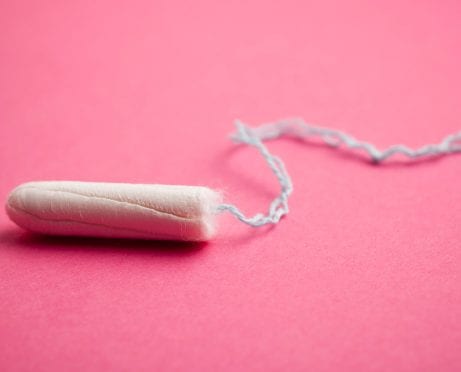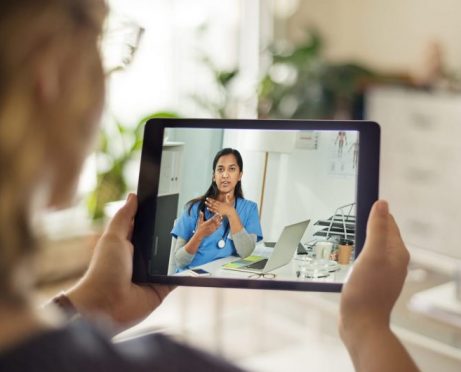
Let’s talk about sex, baby.
Managing your sexual health can be an awkward endeavor for many men, to say the least. The idea of unpacking your sex escapades (henceforth referred to as sexcapades) to a medical professional — who, though well-trained and educated, is still a stranger — evokes enough social anxiety to kill any horny teenager.
 On top of that, if you’re uninsured (or under-insured), a visit to the doctor’s office — and the possibility of paying for prescription medication out of pocket — adds an additional layer of financial worries.
On top of that, if you’re uninsured (or under-insured), a visit to the doctor’s office — and the possibility of paying for prescription medication out of pocket — adds an additional layer of financial worries.
In truth, there’s a hidden cost to not getting your junk checked.
With an estimated 68 million new sexual infections every year, the total nationwide cost of sexually transmitted diseases (STDs) amounts to $16 billion annually, according to the Centers for Disease Control and Prevention (CDC).
Though many STDs are asymptomatic at the time of infection — meaning you won’t notice or feel any physical signs of illness — some can be carried with you for life if not treated. As such, a sexually transmitted disease can become detrimental to your health — and the health of anyone you sleep with — and hurt your finances when you least expect it.
Therefore, addressing the sexually active elephant in the room in your 20s and 30s is the best strategy for your both body and your wallet. And even if you’re uninsured, you can manage your sexual health easily, and cheaply, with these five steps.
1. Get Tested for Free
Getting tested is the most important step you can take in maintaining your sexual health, but many men have hang-ups about schlepping to the clinic or doctor’s office.
The inherently awkward nature of STD testing is a roadblock to actually getting tested.
But many young men also don’t head to the doctor for a chat due to concerns of privacy and a misunderstanding of sexual health risks, according to an article published in the Journal of Adolescent Health, which analyzed the frequency with which men aged 15 to 25 get tested.
In fact, among those surveyed who were sexually active, nearly 42 percent believed they were not at risk for a sexually transmitted disease at all, an assertion that is, by any account, ballsy.
The tough love of the situation is that if you’re sexually active, you either currently have an STD or you don’t. Not knowing does nothing to change this fact.
As such, taking the initiative to get tested now, regardless of whether or not you have symptoms, is a wise deterrent to reducing the cost of sexual health-related treatment down the road. Plus, there are ways to get tested that avoid the $30 co-pay of the doctor’s office.
Planned Parenthood
A popular low-cost, potentially free option can be found at Planned Parenthood. The organization places a strong emphasis on providing quality sexual health services while remaining mindful of individuals with little disposable income. Use their health-center locator to find a clinic close to you.
Make sure to call ahead to discuss what options the clinic has available. Depending on your yearly earnings, you may qualify for a free test. If you have insurance through the Affordable Care Act (ACA) or Medicaid, it’s likely that your test will be covered or extremely cheap.
Local Clinics
Alternatively, you could turn to a local health clinic, looking through the National Association of Free and Charitable Clinics (NAFC) website, the CDC’s national database of free and affordable health centers, and the AIDS Healthcare Foundation’s (AHF) service locator, the last of which focuses specifically on HIV and AIDS testing.
The range of services and cost varies from location to location, so you should call before you go. If you’re really hard up for cash but need to get tested ASAP, consider consulting AHF’s partner websites freeSTDcheck.org and freeHIVtest.net; despite having what some might perceive as clickbait-y URLs, both websites are linked to the AHF and provide a list of centers where services are offered for free, no strings attached.
2. Grab Some Cheap Antibiotics
So you went and got tested and your suspicions were confirmed: You’ve got an STD. While you might be kicking yourself for not being careful enough, keep in mind that many infections (such as genital warts, syphilis, and herpes), can be contracted even if you wear a condom, and that certain STDs stay with you for life; HPV and herpes are two STDs that antibiotics don’t cure.
But what can you do to get affordable treatment for a sexually transmitted infection (STI)? Despite many people’s preconceived notions about its focus lying solely in family planning, once again, Planned Parenthood has a fantastic, national network of clinics and health centers where you can get the necessary antibiotics to address your specific infection.
“Planned Parenthood is a leader in STI testing and treatment, and one of the nation’s leading HIV-testing providers,” says June Gupta, the organization’s associate director of medical services.
“Each year, Planned Parenthood health centers provide more than 4.7 million STI tests and treatment, including more than 740,000 HIV tests,” she adds.
Located in all 50 states as well as the District of Columbia, Planned Parenthood operates more than 600 health centers nationwide.
Affordable Options
In discussing the organization’s mission to provide sexual health resources, Gupta is quick to highlight the organization’s mission in making sure these resources are affordable, especially to those who are uninsured (or under-insured).
“STI testing and treatment can be free or low cost with Medicaid and other government programs,” she says. “And some clinics — including many Planned Parenthood health centers — offer free or low-cost STI tests and treatment, depending on your income.”
“If you’re worried about cost,” she continues, “check with your local Planned Parenthood health center to see if they can hook you up with STI testing and treatment that fits your budget.”
Online Resources
If getting to Planned Parenthood is difficult, there are telemedicine services like CallOnDoc or Teladoc who can prescribe treatment online for as low as $24 — regardless of your insurance coverage.
Though these services aren’t free, they’re a hell of a lot cheaper than getting treated for complications related to an unaddressed sexually transmitted infection — ranging from a urethral infection to swollen testicles. Bite the financial bullet now before you’re face up on an operating table.
3. Get Prepped with PrEP
It’s recommended that all gay and bisexual men in nonmonogamous relationships, or anyone who has shared needles while using intravenous drugs, take pre-exposure prophylaxis — also known as PrEP — according to the CDC.
While anyone can contract HIV, statistics from the Department of Health and Human Services demonstrate that gay and bisexual guys account for the majority of new diagnoses. And though it’s not a surefire way of preventing HIV, data from the CDC confirms that taking PrEP on a daily basis reduces the risk of getting HIV by more than 90 percent.
Pair that with the estimated lifetime cost of treating HIV — which tragically can average more than$360,000 per person — and PrEP becomes a financial no-brainer. And while getting it for a grand total of $0 is a little bit more difficult that copping free antibiotics, there are tools available to make the bottom line more affordable.
Gilead (the drug manufacturer) offers patient assistance programs that can net you a zero dollar co-pay per prescription for those with commercial insurance. While it can be a difficult, legalese-ridden process to get reimbursed for your PrEP, there are intermediaries who can make it easier.
In particular, Nurx is a highly rated web service that’s very effective in providing free or low-cost PrEP. Nurx claims that almost all their patients pay nothing out of pocket for medication, and the service also supports [works with?] individuals on Medicaid and Medicare.
“Ninety-nine percent of our patients pay $0 for their medication. That’s largely because we work very closely with our patients to navigate co-pay and payment assistance programs,” says Nurx brand and communications lead Allison Berry. “We have a dedicated team of PrEP navigators who are experienced in helping all of our patients get enrolled in a payment assistance program.”
If you use Nurx, you’ll have to pay a $12 consultation fee every time you renew your prescription, which is done every three months, in addition to the cost of lab testing fees (which are either $25 with insurance, or $129 out of pocket with no insurance). Afterward, Nurx then steps in to get you enrolled in a payment assistance program — one that accommodates you whether or not you’re insured.
“If the patient has commercial insurance, our navigators enroll them for a Gilead Copay Card, and if they do not have insurance and they qualify for Advancing Access, we walk the patient through the enrollment process,” Berry says.
“For any patient that does not have health insurance coverage for PrEP and does not qualify for one of those two programs, we always will assist them in finding a local clinic with more affordable PrEP options for a warm handoff.”
Once qualified for either of these two programs, Nurx will cover the cost of medication and you’ll be able to receive the actual PrEP medication for free.
In total, you’ll either pay $37 with insurance or $141 without it every three months — much better than the monthly out-of-pocket cost, which according to a Gilead pharmacy service representative, can cost anywhere from $2,000 to $5,000.
Keep in mind that these days Medicare and Medicaid, as well as a number of private insurers, cover PrEP. And while, yes, it’s a pain to be recompensed for medication, or to pay additional cash to get necessary medicine, it’s far cheaper than the six-figure cost of living with HIV.
4. Cop Some Free Protection
Even though they’re on the cheaper end of men’s sexual health care, condoms can become an expensive component of your monthly budget if you don’t plan ahead of time.
Condoms
A three pack of Trojans will set you back roughly $11 at your local pharmacy. Speaking from personal experience, when I was a broke college student in a committed, protection-positive relationship, I grimaced every time I purchased condoms in the week leading up to payday, mainly because I knew there was a myriad of free latex resources available to me had I planned in advance.
Both the low cost of getting treated for an STI and the more than $250,000 it takes to raise a kid to the age of 18 vastly exceed the three bucks and change you’d pay for a rubber. That said, if you’re particularly financially savvy and want to save on the cost of condoms, there are resources available to you.
The AIDS Healthcare Foundation provides free condoms and lubricant at their nationwide locations, and (again, sorry to beat a dead horse) Planned Parenthood has free or cheaper-than-the-pharmacy options available in-house. I called a few locations around the northeastern United States, and all of the centers were able to provide a three pack either for free or for $6 — cheaper than what you’d find in store.
Plus, if you’re anything like me and, despite being a grown man, still feel a degree of social anxiety from purchasing protection in real life, you can buy in bulk online, saving yourself some scrap in the process.
You can get a 48-count pack, which usually lasts me a year a week, for $16 plus shipping, which totals to about 33 cents per bang. By planning ahead, you can keep safe sex safe for your wallet, which, by the way, is one of the worst places you can put a condom, just so you know.
Lube It Up
As a side note, it may be time for you to reevaluate your relationship with lube. Though lube is often considered a pleasure-oriented accessory, using it can increase the effectiveness of condoms — and prevent your balloon animal from popping before the end of the fair (if you know what I mean).
“Many people don’t consider this, but condoms are prone to user-failure,” says Madison Marko, a former peer sexual health educator at Columbia University. “If they’re not stored in a cool, dry place, they may rip during sex, negating their protection against sexually transmitted infections and pregnancy.”
“If available, I recommend all couples use lube alongside condoms as an added precaution,” Marko adds.
Fortunately, the above listed free condom resources can also furnish you with some added, friction-averse protection. Alternatively, you can purchase a personal four-ounce bottle of lube for $4 online. Be sure to use only lube that is water-based or silicone, as oil-based products can break your latex more easily. Stay slippery, boys.
5. Plan B-fore You Bang
Though most of the health-forward tips we’ve listed here center around preventing and addressing sexually transmitted diseases and infections, avoiding an unexpected pregnancy should top your list of concerns if you don’t plan on being a parent anytime soon.
We’ve already discussed the cost of child-rearing, but in the immediate term, the cost of terminating a pregnancy in the first trimester ranges from $650 to $750 nationwide, which can put a serious dent in your and your partner’s finances, not to mention any potential emotional repercussions of such a decision.
And even if you’re using condoms, keep in mind they’re effective only 98 percent of the time — a fact that should probably be in HUGE BLOCK LETTERS on the packaging. And that’s if you’re using them 100 percent correctly, meaning wearing them from the first minute of penetrative sex until the last second, roughly three minutes later.
Finding out you’ve had condom failure immediately after sex is, to use the medical term, a bummer.
Pair that with the fact that Plan B — an emergency oral contraceptive designed for usage within 72 hours of unprotected sex — will set you back $50 at the late-night pharmacy, and now you’ve got a huge bummer. If you’re currently sexually active, apply some foresight and have a backup emergency contraceptive on hand, just in case.
“You can buy emergency contraceptives like Plan B from Planned Parenthood, a community health center, or even on Amazon for close to a fifth of the price that you’ll pay at the local pharmacy,” Marko says. “If you’re trying to save money and use condoms as protection, buying Plan B in advance can save you the headache of a pharmacy markup.”
Considering that you’ll save almost $40 by purchasing emergency contraceptive online (in addition to the inconvenience of running to the Rite-Aid or Walgreens), buying ahead of time eases the financial burden — and accompanying dread — of a broken condom. Make the purchase the next time you online shop, and maybe take a minute to check the expiration date on those rubbers while you’re at it.
The Bottom Line on Men’s Sexual Health
Taking control of your sexual health is a necessary step in adulthood, but it doesn’t cost a lot to make one’s bones as a man. Knowing your body, addressing potential infections, and healthily preparing for the future can be done affordably with the right resources. Protect your wallet — among other things — and you’ll bone down in (financial) confidence.










